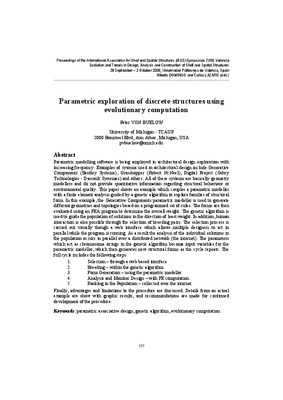JavaScript is disabled for your browser. Some features of this site may not work without it.
Buscar en RiuNet
Listar
Mi cuenta
Estadísticas
Ayuda RiuNet
Admin. UPV
Parametric exploration of discrete structures using evolutionary computation
Mostrar el registro sencillo del ítem
Ficheros en el ítem
| dc.contributor.author | VON BUELOW, Peter
|
|
| dc.contributor.editor | Domingo Cabo, Alberto
|
es_ES |
| dc.contributor.editor | Lázaro Fernández, Carlos Manuel
|
es_ES |
| dc.date.accessioned | 2010-02-25T11:50:59Z | |
| dc.date.available | 2010-02-25T11:50:59Z | |
| dc.date.issued | 2010-02-25T11:50:59Z | |
| dc.identifier.isbn | 978-84-8363-461-5 | |
| dc.identifier.uri | http://hdl.handle.net/10251/7304 | |
| dc.description | p. 577-588 | en_EN |
| dc.description.abstract | Parametric modelling software is being employed in architectural design exploration with increasing frequency. Examples of systems used in architectural design include Generative Components (Bentley Systems), Grasshopper (Robert NcNeel), Digital Project (Gehry Technologies - Dassault Systemes) and others. All of these systems are basically geometry modellers and do not provide quantitative information regarding structural behaviour or environmental quality. This paper shows an example which couples a parametric modeller with a finite element analysis guided by a genetic algorithm to explore families of structural form. In this example, the Generative Components parametric modeller is used to generate different geometries and topologies based on a programmed set of rules. The forms are then evaluated using an FEA program to determine the overall weight. The genetic algorithm is used to guide the population of solutions in the direction of least weight. In addition, human interaction is also possible through the selection of breeding pairs. The selection process is carried out visually though a web interface which allows multiple designers to act in parallel while the program is running. As a result the analysis of the individual solutions in the population occurs in parallel over a distributed network (the internet). The parameters which act as chromosome strings in the genetic algorithm become input variables for the parametric modeller, which then generates new structural forms as the cycle repeats. The full cycle includes the following steps: 1. Selection - through a web based interface 2. Breeding - within the genetic algorithm 3. Form Generation - using the parametric modeller 4. Analysis and Member Design - with FE computation 5. Ranking in the Population - collected over the internet Finally, advantages and limitations to the procedure are discussed. Details from an actual example are show with graphic results, and recommendations are made for continued development of the procedure. | en_EN |
| dc.language | Inglés | en_EN |
| dc.publisher | Editorial Universitat Politècnica de València | es_ES |
| dc.relation.ispartof | Symposium of the International Association for Shell and Spatial Structures (50th. 2009. Valencia). Evolution and Trends in Design, Analysis and Construction of Shell and Spatial Structures : Proceedings | en_EN |
| dc.rights | Reserva de todos los derechos | en_EN |
| dc.subject | Parametric associative design | en_EN |
| dc.subject | Genetic algorithm | en_EN |
| dc.subject | Evolutionary computation | en_EN |
| dc.title | Parametric exploration of discrete structures using evolutionary computation | en_EN |
| dc.type | Comunicación en congreso | en_EN |
| dc.rights.accessRights | Abierto | es_ES |
| dc.description.bibliographicCitation | Von Buelow, P. (2010). Parametric exploration of discrete structures using evolutionary computation. Editorial Universitat Politècnica de València. http://hdl.handle.net/10251/7304 | es_ES |
| dc.relation.conferencename | Symposium of the International Association for Shell and Spatial Structures | es_ES |
| dc.relation.conferencedate | 2009 | es_ES |
| dc.relation.conferenceplace | Valencia | es_ES |






